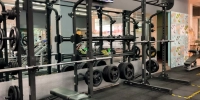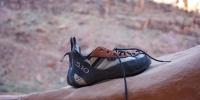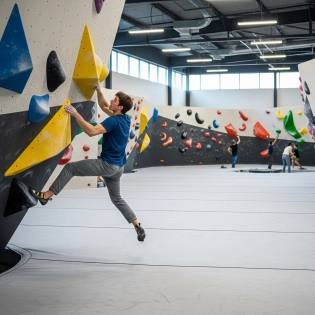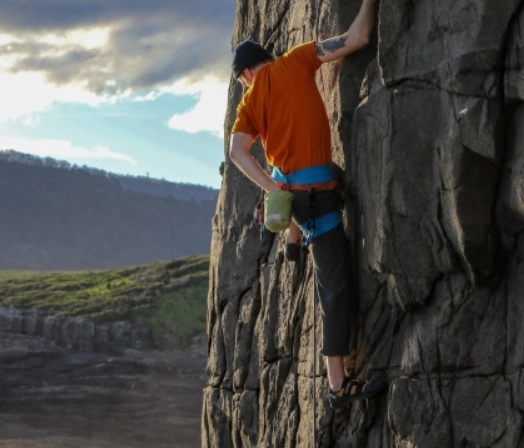







Climbers Point
Generally, you would not wear socks with climbing shoes unless you have a reason for it. Socks can help prevent chafing by providing an extra layer between your toes and the shoes. This could help in cases where you have new climbing shoes that are very tight or that you are not used to yet, or, you are a beginner climber, and you are not used to your climbing shoes yet. In these cases, the climbing shoes may be rubbing against your toes to the point where it actually breaks the skin and peels a thin layer off. Wearing socks can prevent this.
Other than this, though, it is usually preferred to not wear socks, since an important reason for climbing shoes being so tight is so that your foot will not slip inside of it or move around. Wearing socks can cause your foot to move around in your shoe, even in very tight climbing shoes. This can happen especially in the heel area and when you have difficult heel hooks where you really have to pull on your heel. Wearing socks can cause your shoes to not stay on as tight as they should, and could result in your foot slipping, the heel of the shoe coming off, and even in injuries if your foot slips in a risky way.
So the recommended way to wear climbing shoes is without socks. If you really want to, though, you can find a thin pair of socks to wear, just until your toes get used to the friction of the climbing shoes.

Climbing shoes are bent downwards to enable you to put more weight on very small edges. By being bent downwards, you are able to apply more force on the small edge without the shoe slipping off.
Bent climbing shoes are normally better for bouldering and overhanging routes, as they allow you to have a better grip on the holds, which enables you to pull harder on your toes and keeping your body close to the wall. All of this allows you to reserve more energy in your arms.
Though they are mostly used for bouldering and overhanging routes, they are not limited to them. There are many climbers who prefer aggressive downturned climbing shoes over neutral ones for sport climbing also.
Another element of aggressive climbing shoes is a slight twist in the direction of the big toe. This allows you to put even more force and power onto the toes, allowing you to have an even better stance on those very small edges.

Climbing shoes are not meant to hurt, they are meant to be tight, which for some, do mean that they may hurt a little bit.
How tight they should be, though, depends on the climber.
Climbers need their climbing shoes to be tight so that they can stand on very tiny and delicate holds, and for their feet to no slip or move within the shoe, or at least to minimize that as much as possible.
This, though, is usually a requirement of high level climbers, those who have been climbing for years and can actually benefit from the added performance the shoes can give.
Beginner climbers on the other hand have no reason to wear shoes that are so tight, as the routes they will be climbing will not require such delicate and precise feet placements, and will not have such small holds.
As climbers progress up the grades and climb harder and harder routes, it does make sense to start getting tighter shoes, but only as required. There is no point in having super tight and expensive shoes if they don't actually bring you any value in comparison to beginner climbing shoes or to just looser climbing shoes, especially if the tighter shoes are just painful.
With all of that said, there is a slight level of pain that climbers may feel with climbing shoes, mainly with new shoes, but this has more to do with the fact that the shoes are just not comfortable, it shouldn't be actual pain.
Climbing shoes are not comfortable, and this discomfort may be the cause of some pain, but, this is temporary until your feet get used to climbing shoes.
Once you have been climbing for a while, you will actually start to feel quite comfortable in climbing shoes, and yes, you may even refer to them as "comfortable".
There is also a point to make about fitting the right shoe for the right foot.
Not all shoes fit everyone. So it is important to try on different pairs and to find the ones that actually fit your feet well. This is because climbing shoes are all made differently. They are made from different materials, and can have slightly different shapes and bends, especially in the toe area and the heel.
First, the real key to making climbing shoes not hurt is to actually buy the correct size, and to not downsize to the point where you are in unbearable pain.
Sizing down is fine, as long as you know what you are doing and not sizing down too much, and that you actually understand the concept of sizing down and how shoes stretch.
The other crucial key, assuming you have bought the correct size, is to just wear them and climb in them. That really is the best way to stretch them.
There are many different methods of stretching them, such as just wearing them in the house, sleeping in them, showering in them, and many others.
A quick search can show you a lot of crazy methods, which some may work, but, even after doing those methods and having the shoe actually stretch, when you put it on and climb in it, it still won't be comfortable since it was not stretched in the same way that you would stretch it while climbing.
When you climb, your shoes bend and twist in all kinds of ways, ways which can't really be mimicked by just walking in them, sleeping in them, or putting them in the freezer, or by any of the other strange methods. Your feet need to be in them and need to be what stretches them.
Just climb in them, they will stretch and fit your feet much better, and they will be stretched in according to the way you actually use them on the wall.
I remember when I bought my second pair of climbing shoes, the ones I bought to replace my beginner shoes I wore for 6 months. I ordered them online and bought a size and a half (at least!) too small.
They were extremely painful to wear, even to just stand in.
My friend, with many years of experience, kept saying it's fine and that I should just wear them and climb in them, and they will loosen up.
I did as he said, but this didn't really work. They did loosen up a little bit even after climbing in them for just a few minutes, they did feel slightly better, but they were still horribly painful to wear.
The reason is, they were just too small! Climbing shoes should not be too small to begin with, even if you are expecting them to stretch and loosen up.
Also, they were synthetic. Synthetic shoes do not stretch as much as leather shoes stretch, so even if they would have stretched eventually by using them and climbing in them, they would not stretch enough to actually make them not hurt, they were at least 1.5 sizes too small to begin with.
And those are the two main points that I have used since then when buying shoes and making them not hurt:
1. Understand what you are buying
If they are leather, they will probably stretch a lot after using them for a while, so if you buy a smaller shoe size, it will probably be uncomfortable in the beginning, or even slightly painful, but as you use them, they should loosen up to be a great fit, just as long as you don't go down in size too much, they shouldn't actually be really painful.
If they are synthetic, keep in mind that they will probably not stretch too much, and if you buy size 10, they will probably stretch at the most to 10.5. I have bought since then 4 pairs of shoes, all synthetic, and none of them have noticeably stretched. They are still as tight as I bought them.
So keep this in mind when buying shoes, since if you buy synthetic shoes that are a few sizes smaller while thinking that they will stretch after you use them and that they will be a good fit, you may be quite disappointed.
2. Wear them!
My friend was actually right, wearing the climbing shoes does stretch them, even for that session, making them much more bearable throughout the session compared to when you are just putting them on.
Of course, if you downsize synthetic shoes too much, like in my accidental case, wearing them probably won't help much. But if the shoes are properly sized to begin with, then you should be fine with just wearing them and climbing with them, they should stretch and loosen up.

Rock climbing shoes are simply called climbing shoes. Some who mainly do bouldering may refer to them as bouldering shoes, but those too are just climbing shoes.
Belay means to secure a rope around an object such as a pin, rock, cleat, or a belaying device.
When you are belaying someone, you are securing the rope in a belay device such as a Grigri.





